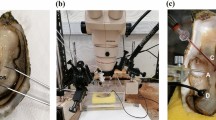Summary
-
1.
The nucleotide adenosine 5′-monophosphate (AMP) is a potent chemoattractant for the marine shrimp,Palaemonetes pugio. Behavioral bioassays of AMP in the concentration range of 0.1 to 1000 μmol/l show that the dose-response curve is biphasic with the maximum response occurring at about 10 μmol/l.
-
2.
AMP is much more potent than ADP. ATP and adenosine are inactive as attractants.
-
3.
Bioassays of 28 substances structurally related to AMP show that the integrity of both the adenosine and the ribose phosphate moieties are required for maximal activity. However, the integrity of the ribose phosphate is of special importance since most of the substances having changes in this moiety are completely inactive as attractants.
-
4.
The response to AMP is antagonized by theophylline and adenosine.
-
5.
The behavioral results suggest that the shrimp possesses external chemoreceptors with marked similarities to the R-type, or P1-type, purine receptors that are present internally in vertebrate tissues.
-
6.
Comparisons are made of the structure-activity relationships of nucleotides stimulating behavioral responses in the shrimp and other lower organisms. Possible evolutionary relationships between external chemoreceptors in lower organisms and internal receptors for neurotransmitters and modulators are noted.
Similar content being viewed by others
Abbreviations
- AMP :
-
adenosine 5′-monophosphate
- IMP :
-
inosine 5′-monophosphate
- UMP :
-
uridine 5′-monophosphate
References
Ache BW (1982) Chemoreception and thermoreception. In: Atwood HL, Sandeman DC (eds) The biology of Crustacea, vol 3. Academic Press, New York, pp 369–398
Boyd CAR (1979) Chemical neurotransmission: an hypothesis concerning the evolution of neurotransmitter substances. J Theor Biol 76:415–417
Burnstock G (1980) Purinergic nerves and receptors. Prog Biochem Pharmacol 16:141–154
Carr WES (1978) Chemoreception in the shrimp,Palaemonetes pugio: the role of amino acids and betaine in elicitation of a feeding response by extracts. Comp Biochem Physiol 61A:127–131
Carr WES, Gurin S (1975) Chemoreception in the shrimp,Palaemonetes pugio: comparative study of stimulatory substances in human serum. Biol Bull 148:380–392
Derby CD, Atema J (1982) Narrow-spectrum chemoreceptor cells in the walking legs of the lobster,Homarus americanus: taste specialists. J Comp Physiol 146:181–189
Fain JN, Malbon CC (1979) Regulation of adenylate cyclase by adenosine. Mol Cell Biochem 25:143–169
Freund RJ, Littel RC (1981) SAS for linear models. SAS Institute Inc, Cary, NC, USA
Friend WG, Smith JJB (1977) Factors affecting feeding by bloodsucking insects. Annu Rev Entomol 22:309–331
Friend WG, Smith JJB (1982) ATP analogs and other phosphate compounds as gorging stimulants forRhodnius prolixus. J Insect Physiol 28:371–376
Fuzessery ZM, Carr WES, Ache BW (1978) Antennular chemosensitivity in the spiny lobster,Panulirus argus: studies of taurine sensitive receptors. Biol Bull 154:226–240
Greengard PC (1981) Intracellular signals in the brain. The Harvey Lectures, Series 75. Academic Press, New York, pp 277–331
Haldane JBS (1955) Animal communication and the origin of the human language. Sci Prog 43:385–401
Kittredge JS, Takahashi FT, Lindsey J, Lasker R (1974) Chemical signals in the sea: marine allelochemics and evolution. Fish Bull Nat Mar Serv 72:1–11
Kiyohara S, Hidaka I, Tamura T (1975) Gustatory response in the puffer. II. Single fiber analyses. Bull Jpn Soc Sci Fish 41:383–391
Lee CH, Evans FE, Sarma RH (1975) Interrelation between glycosidic torsion, sugar pucker, and backbone conformation in 5′-β-nucleotides. J Biol Chem 250:1290–1296
Lenhoff HM, Heagy W (1977) Aquatic invertebrates: model systems for study of receptor activation and evolution of receptor proteins. Annu Rev Pharmacol Toxicol 17:243–258
Londos C, Wolff J (1977) Two distinct adenosine-sensitive sites on adenylate cyclase. Proc Natl Acad Sci USA 74:5482–5486
Londos C, Cooper DMF, Wolff J (1980) Subclasses of external adenosine receptors. Proc Natl Acad Sci USA 77:2551–2554
Mackie AM, Adron JW (1978) Identification of inosine and inosine 5′-monophosphate as the gustatory feeding stimulants for the turbot,Scophthalmus maximus. Comp Biochem Physiol 60A:79–83
Mato JM, Jastorff B, Morr M, Konijn TM (1978) A model for cyclic AMP-chemoreceptor interaction inDictyostelium discoideum. Biochem Biophys Acta 544:309–314
Morse DE, Hooker N, Duncan H, Jensen L (1979) Aminobutyric acid, a neurotransmitter, induces planktonic abalone larvae to settle and begin metamorphosis. Science 204:407–410
Phillis JW, Wu PH (1981) The role of adenosine and its nucleotides in central synaptic transmission. Prog Neurobiol 16:187–239
Phillis JW, Kostopoulos GK, Edstrom JP, Ellis SW (1979) Role of adenosine and adenine nucleotides in central nervous function. In: Baer HP, Drummond GI (eds) Physiological and regulatory functions of adenosine and adenine nucleotides. Raven Press, New York, pp 343–359
Stone TW (1981) Physiological roles for adenosine and adenosine 5′-triphosphate in the nervous system. Neurosci 6:523–555
Torii K, Cagan RH (1980) Biochemical studies of taste sensation. IX. Enhancement of L-[3H] glutamate binding to bovine taste papillae by 5′-ribonucleotides. Biochim Biophys Acta 627:313–323
Van Haastert PJM, Jastorff B, Pinas JE, Konijn TM (1982) Analogs of cyclic AMP as chemoattractants and inhibitors ofDictyostelium chemotaxis. J Bacteriol 149:99–105
Wolff J, Londos C, Cooper DMF (1981) Adenosine receptors and the regulation of adenylate cyclase. In: Dumont JE, Greengard P, Robison GA (eds) Advances in cyclic nucleotide research, vol 14. Raven Press, New York, pp 199–214
Author information
Authors and Affiliations
Rights and permissions
About this article
Cite this article
Carr, W.E.S., Thompson, H.W. Adenosine 5′-monophosphate, an internal regulatory agent, is a potent chemoattractant for a marine shrimp. J. Comp. Physiol. 153, 47–53 (1983). https://doi.org/10.1007/BF00610341
Accepted:
Issue Date:
DOI: https://doi.org/10.1007/BF00610341




